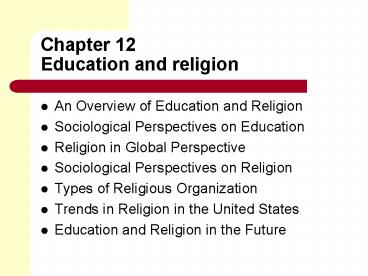Chapter 12 Education and religion - PowerPoint PPT Presentation
1 / 14
Title:
Chapter 12 Education and religion
Description:
Title: PowerPoint Presentation Author: stacy Last modified by: stacy Created Date: 8/3/2001 6:03:11 PM Document presentation format: On-screen Show – PowerPoint PPT presentation
Number of Views:58
Avg rating:3.0/5.0
Title: Chapter 12 Education and religion
1
Chapter 12Education and religion
- An Overview of Education and Religion
- Sociological Perspectives on Education
- Religion in Global Perspective
- Sociological Perspectives on Religion
- Types of Religious Organization
- Trends in Religion in the United States
- Education and Religion in the Future
2
FunctionalistsFunctions of Education
- Manifest functions
- Socialization
- Transmission of culture
- Social control
- Social placement
- Change and innovation
3
FunctionalistsFunctions of Education
- Latent functions
- Restricting some activities.
- Matchmaking and production of social networks.
- Creation of a generation gap.
4
Conflict Perspective
- Education is a vehicle for reproducing existing
class relationships. - Unequal funding is a source of inequality in
education. - Access to colleges and universities is determined
not only by academic record but also by the
ability to pay.
5
Symbolic Interactionist Perspective
- Self-Fulfilling Prophecy- students perform
according to the expectations of their teachers. - Students labeled as gifted may achieve at a
higher level because of the label. - Some girls learn to attribute success to effort
while boys learn to attribute success to
intelligence and ability.
6
Religion
- Seeks to answer important questions such as why
we exist, why people suffer and die and what
happens when we die. - Comprised of beliefs, symbols and rituals.
- All known groups over the past 100,000 years have
had some form of religion.
7
Four Main Categories of Religion
- Simple supernaturalism - the belief that
supernatural forces affect people's lives
positively or negatively. - Animism - the belief that plants, animals, and
elements of the natural world are endowed with
spirits that impact events in society.
8
Four Main Categories of Religion
- Theism - belief in a God or Gods.
- Transcendent idealism - belief in sacred
principles of thought and conduct, such as truth,
justice, life and tolerance for others.
9
Functionalist Perspective
- Religion has 3 important functions
- Providing meaning and purpose to life.
- Promoting social cohesion and a sense of
belonging. - Providing social control and support for the
government.
10
Conflict Perspective
- According to Karl Marx, religion is the "opiate
of the people." - Max Weber argued that religion could be a
catalyst to produce social change.
11
Symbolic Interactionist Perspective
- Religion serves as a reference group to help
people define themselves. - Womens versions of a certain religion usually
differ from mens versions.
12
Trends in Religion in the U.S.
- The rise of a new fundamentalism has occurred at
the same time as a number of mainline
denominations have been losing membership. - Some members of the political elite in Washington
have vowed to bring religion "back" into schools
and public life.
13
Goals 2000 Educate America Act
- Passed by Congress in 1994 to challenge the
nations public school system to meet specific
goals by 2000. - Very little progress has been made.
- The stated goals are overly idealistic.
14
Goals 2000 Educate America Act
- Three key goals
- Students leave grades 4, 8, and 12 with
competency in English, math, science, history,
and geography. - U.S. students will lead in science and
mathematics achievement. - Every adult will be literate.































